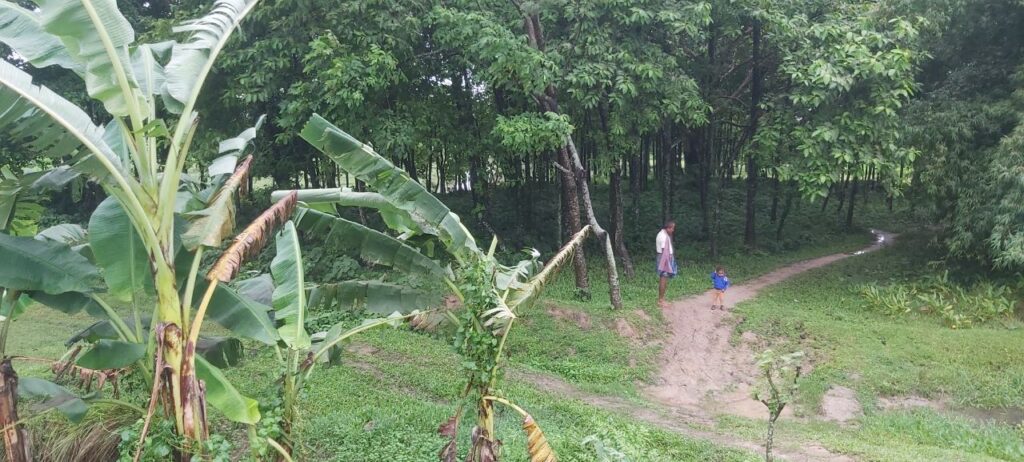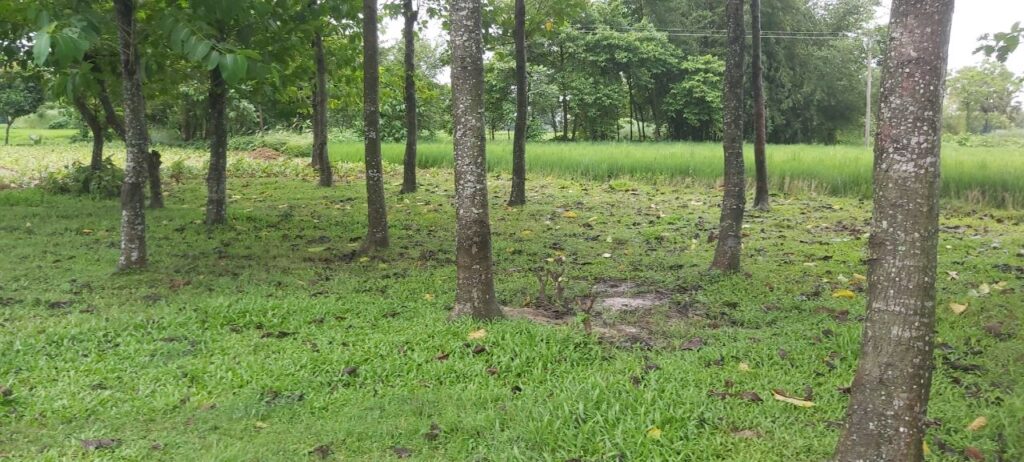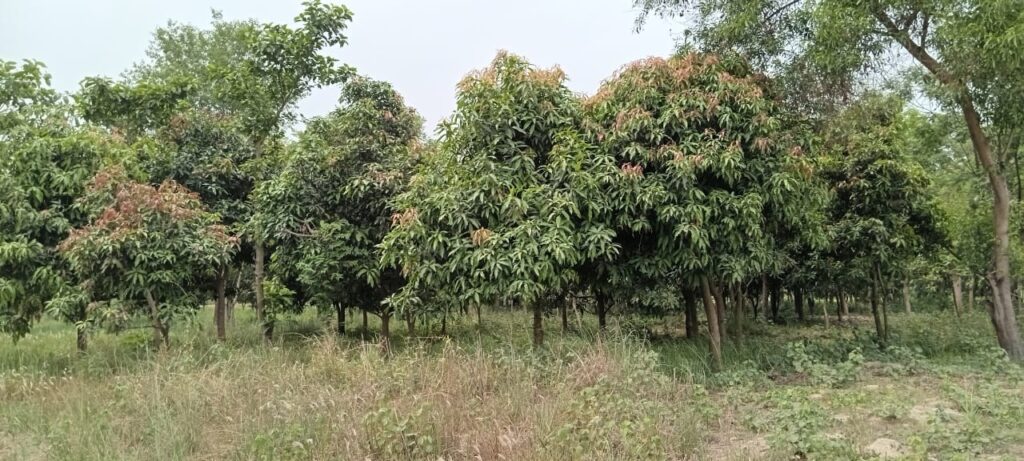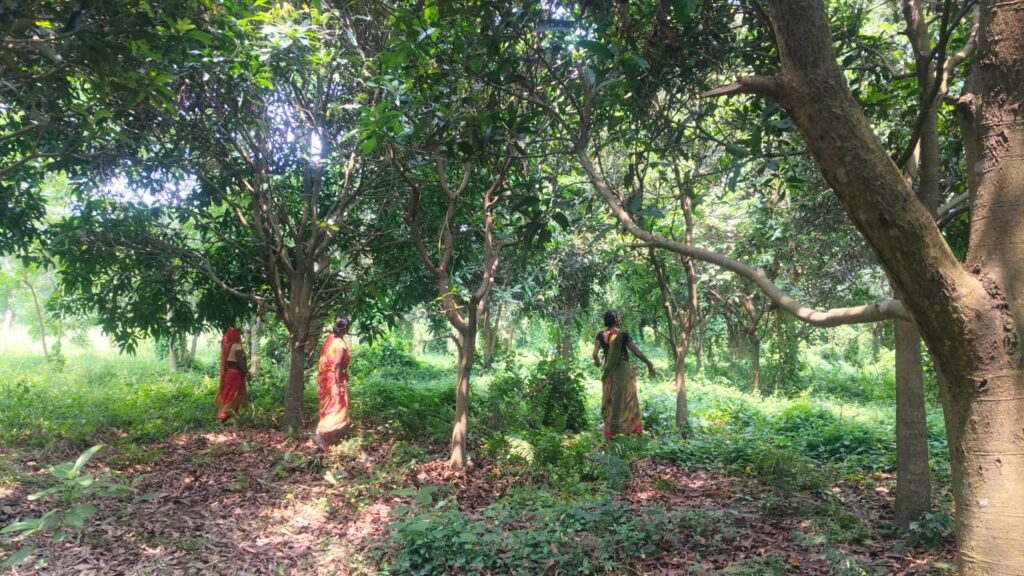ORGANIC FARMING
In 2022 The Kisanon ki Bari (Farmers’ Gardens) and the Plantation for Food and Forest project were taken over by a new group of old and new associates of the trust. They named the project Madhumakki Farm.
The trustees are making a determined attempt to bring support to the selected farmers in Baharwari, Araria District. The project has started off on land that belongs to Hari Sharan. He also bought some land from a sister and three brothers and this land is part of the Madhumakki Farm. The farmer members of the team are Gurudeo Malakar, full time manager, Bhalo Devi, Ramayan Malakar, Radha Devi, Manoj Mandal, full time farmers, Amar Lal Mandal, Laxmi Mandal, Manjita Devi, Renu Devi, Rekha Devi, Julo Devi, Mandodari Devi, and Parwati Devi, half time farmers. In this group five are landless. The hope is that the half-time farmers who are also doing sharecropping and own land farming in the other half of the day, will join the next project from 2025 to 2029 in a new capacity as farmer members who put their own land into Madhumakkhi Farm land for organic farming also; and that the trust may become a catalyst for regenerative organic farming in the area. The convenient legal form of ownership for the venture is yet to be determined. The trustees are committed to disseminating ideas and practices that defend old knowledge, old varieties, improved socio-ecological relationships, and to combine local knowledge with new methods and machines as needed.
We started by doing an analysis of the fields that we were given to farm, and found that there are two types of plots: the small scattered low land plots measuring a total of around 6.75 acres suitable for the paddy – lentil – mustard cropping pattern or similar, and secondly the highland plots suitable for food forests or any other non-flood crop. On all the fields, highland and low land, the soils are depleted after five decades of intensive application of chemical fertilisers and pesticides. Growing cash crops such as summer paddy, maize and wheat is the bane of agriculture in Bihar and is actually a threat to all of life including us humans. Sadly today all our neighbours have succumbed to the latest craze for growing maize both on low lands after paddy and on highland. Obviously this is totally unsustainable and will stop again in a year or two. And then what? Nothing grows between the plants, there are no hedge rows, biodiversity is obliterated, and there are no insects. The soils will be worse and the lovely paddy wetlands will be dried up. See Photo 1, showing Charbighya, a low land plot with depleted soils where a huge effort must be made to build back soil fertility.
List of higher land fields with three year old food forest: Kamalsari 1.7 acres, Vermicompost field, 0.91 acres, Kharoor 1.54 acres, Rankali 1.33 acres. Bamboobari, Kadamb Bari and Ramna, 10 years old, measure a total of 2.52 acres. Guest house, power plant and nursery plot measure 0.6 acres. Biren’s land with trees measures 0.54 acres, and Safai centre is 0.31 acres.
The low land fields with paddy-masoor-mustard system are Charbighya 2.73 acres, Muraliya 1 and 2, 0.72 acres, Bhora 1 and 2, 1.04 acres, Navkathya 0.76 acres, Barka Parthi 0.2 acres. Small nallah is 0.08 acres.
An alternative ideal type of ecologically regenerative farming on the low land would be to do paddy followed by lentils followed by mustard and finally mung on the low lands. Or millet may be grown in the winter season. This is an ideal rotation where the rainwater and floods bring fertiliser during the paddy season and the soil is nearly moist enough for the following four crops needing barely one or two irrigations the rest of the year. This ideal cropping pattern also has nitrogen fixing crops, ready for the next paddy crop. This traditional form of organic farming was destroyed by the introduction of irrigated wheat in the seventies, irrigated summer paddy around the year 2000, and now irrigated maize. For our 5 acres of low lands our aim is to get back to the traditional organic practice, an uphill task.
For our high land fields our plan is two fold, one part of which we have started to implement, the second part of which is yet to come. From 2022 onwards we started to implement syntropic food forestry, a kind of agro-forestry. We planted food forests on the highland plots, and today we have a good numbers of trees with adequate girth and height commensurate with the soil conditions. We currently have 2655 trees spread across 11 sites including one site exclusively for Bamboo and one exlcusively planted with Kadamb. On these plots there are a total of 475 Viju Mango, 432 Kadamb, 165 Guava, 165 Mahogany, 154 Arjun, 154 Jiyal, 142 Aamla, 102 Eucalyptus, 101 Aaksiya auriculiformis, 79 Berries, 70 Peltophorum, 61 Jharul, 48 Chokendi, 48 Gamhar, 48 Fithar, 47 Siris, 39 Kachnar, 39 Sisham, 36 Sakhua, 29 Jhunjhuna, 26 Sagwan, 23 Bel, 23 Bahera, 23 Kathal, 20 Grafted Mango, 16 Desi Banana, 11 Anar, 9 Baken, 12 Gliricidia, 6 Susabool, 5 Bair, 4 Bargad, 3 Amaltas. There are 28 clumps of Lemon grass, (100? check) clumps of Bamboo, 1 Neem, and 1 Peepal. At various times we grew Turmeric finger seed, Turmeric round seed, Simhal, Aubergine, Amaranthus (Lakho green leaf), cauliflower, chili, chira mira, Ganhari Green leaf, and spinach in between the trees. We tried and failed with Hybrid Banana and Charita GP Banana. Please see Photo 2. It shows team members making a way across the river to take the tractor to the highland for levelling the soil ready for planting the trees on the high land on the other side, in October 2022.
Proposed Lemon Tree Project to enhance Food Forests from 2026 to 2029
Building on the foundation of team building and soil management of the last 4 years, our plan now for 2026 to 2029 is to do intensified syntropic agriculture on our food forest plots. Syntropic agriculture is a system of farming in which useful trees of varying sizes are grown in a manner that emulated natural forests. There are the overstorey trees, the high, medium and low trees, and the ground hugging shade loving plants. The idea is that the farmers should harvest from all levels at different seasons and over different harvesting cycles of one, three or 40 years or never depending on the tree. There are annual biomass plants for quick compost. Given this plan, and given our failures and learning described above, our plan for 2026 to 2029 is to wall the food forests to keep out people and cattle and goats, and to plant a total of up to 1000 – 5000 lemon trees in 5 acres of food forest. There will lemon, bamboo and bair as live thorny fence, and more lemon in the spaces between the high trees inside the newly walled enclosed field. The biomass plants and vermicomposting on site will provide the fertiliser.
The main learning from the three years of food forestry is that because of the cooking fuel crisis and the fodder crisis in the village it is impossible to keep villagers out of the food forests by mere request. Leaves, twigs, branches, root and stem material that should accumulated on the forest floor to enhance the soil, is taken away by villagers for cooking fuel and cows and goats. Thus the forest floor is just as it was when we started. No new humus has been added. But at least now there are trees. The second learning is related to this failure. Because the forest floor did not naturally regenerate, the fruit trees did not do well and we did not harvest much fruit. The attempt to build AmritMitti compost heaps and fertilise the trees in this way with this cow dung and cow urine concoction proved too difficult as we do not have our own cows and there was never enough biomass to collect on our forest floors or from anywhere else. For these reasons we did not get a decent first harvest from our food forests, which is always the sine qua non of making farmers feel that a new farming practice actually is worthwhile. Though we were aware of the problem of soils and we had planned our food forests as syntropic fruit farms, a form of agriculture where native fruit trees are intermixed with native forest timber trees, we could not adequately protect our trees, the soil fertility problem went unaddressed and we didn’t get a harvest. Photo 3 shows our experiment, now discontinued, making Amrit Mitti heaps at Kamalsari.
In 2024 we decided to address the soil problem by going all out with vermicomposting. We had a low level vermicomposting activity since 2022 and in June 2024 we intensified the vermicomposting by intensifying the planning, collection, and processing of water hyacinth. Ponds in neighbouring villages were identified and 10 part time workers collect 1000 kilos of wet water hyacinth a day. The 1000 kg wet water hyacinth per day decomposes into 250 kilos of decomposed material that is fed to the worms. We will have composted a final amount of 20000 tonnes in one year from September 2024 to September 2025 that will be ready for a new lemon tree project we are proposing for the food forests.
For 2026 – 2029 the plan is to keep going all out with vermicomposting in situ in each field. This will avoid the problem of having to carry the material twice. Currently we carry the water hyacinth to the pits and then the compost to the fields. From 2026 onwards we will do the composting directly on the edge of the field. Photo 4 shows team members doing vermicomposting, photo 5 shows worms in decomposed water hyacinth.
Proposed Food, Fuel and Fodder experiment 2026 to 2029
Our aim in the beginning had been to understand how much land is needed for a family to live off farming in Bihar. Despite a reluctance by anyone to try this experiment, we thought we could push on with the idea of an experimental farmstead. But in the meantime we have realised that better team working in the farmer group is essential to understanding what the best aims for this organic farming project actually are. We are looking for a new farm manager who will help us implement the second part of our project. We will not build a farmstead, but we will understand the food, fuel and fodder needs of our team members and make the fields which are part of this famr meet their needs in the best way possible. Perhaps we may make a inventory of the family members, land and livestock of all the members, and calcuate what is needed and how to provide it. How much fuel is needed by the group per year, where may it come from? Shall we grow jute again or Dhaincha for fuel? or are there better options? And how can we provide fodder for the cows belonging to members? And how will enough biomass be assured for composting and direct soil improvement through leaf fall and chopping and dropping? Our farming may provide a model for doing organic biodiverse food forestry that brings soil improvement and improved income and a long term escape from horrible labour market conditions in Bihar. Our model would be highly unusual in this region, and yet, as we have the possibility of investing some capital for this new model. we feel that it would be worth doing. Will the farmers be able to sufficiently supplement their existing income with additional resources from our farm in order to get more milk, assured cooking fuel, more fruit and vegetables?
The Photo, mistakenly also labelled photo 5, shows low land preparation for paddy July 2025.
Further discussion among the farmer group should lead to greater understanding of what Government is already providing to our team members, how much income families are earning from members working outside the village, and what role the organic farm can play in providing some basics like vegetables and fruit, local good quality rice, other favourite local crops and produce, fodder for livestock, and enough cooking fuel.
Our most successful food forest near our vermicompost pits provides a small scale model of part of the planned planting arrangement that might provide for all these needs. Photo 6 shows our two year old syntropic food forest with water hyacinth for vermicomposting in the foreground. This plot was properly fenced and the results have been excellent.
This organic farming project is taking place on land made available to the trust by Hari Sharan, as mentioned above. We are not quite clear as yet what form the ownership and / or rental model for this collaboration between villagers, workers, farmers, trust staff, trust trustees, the trust and Hari Sharan himself will take. It is yet to be decided. The plan and hope and expectation is that if we can get one or two more farmers in the village who own land to join with the landless farmers employed by the trust, and if we get more technical support from other people willing to join in, then the stage might be set for starting a Farmer Producer Company with the trust as one of the owners or leassees of land. These questions are at the back of our minds. At the forefront is the need to meet the basic needs of the team members through high land agro-forestry and low land paddy-lentil-mustard systems.
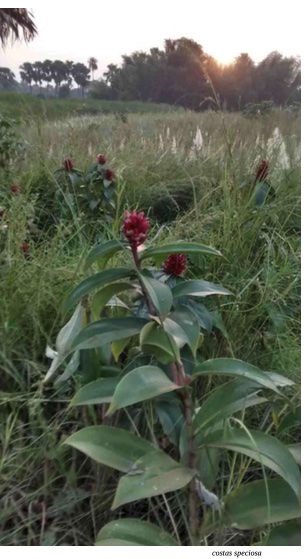
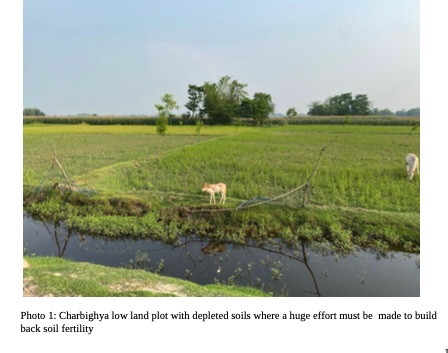
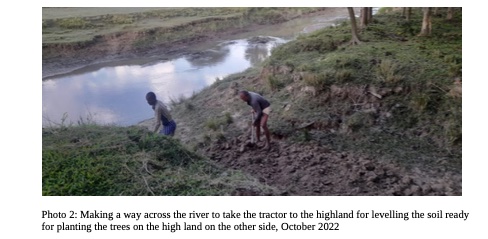
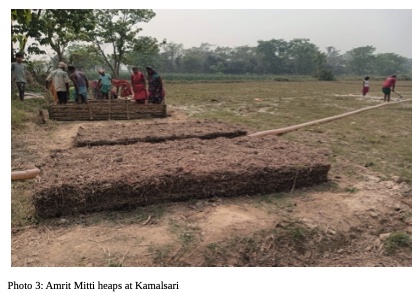
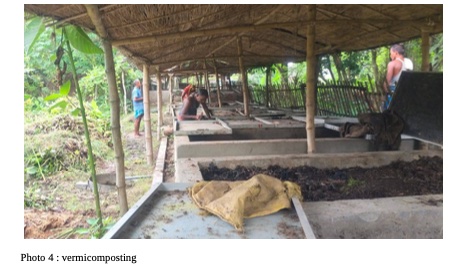
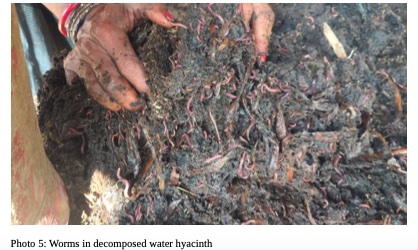
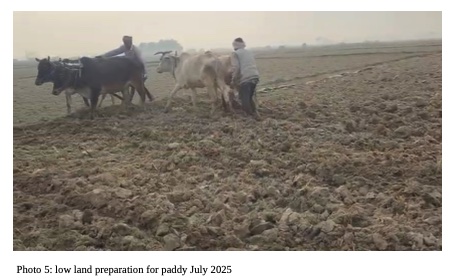

More photos from farming at Madhumakkhi Farm over the last 3 years
